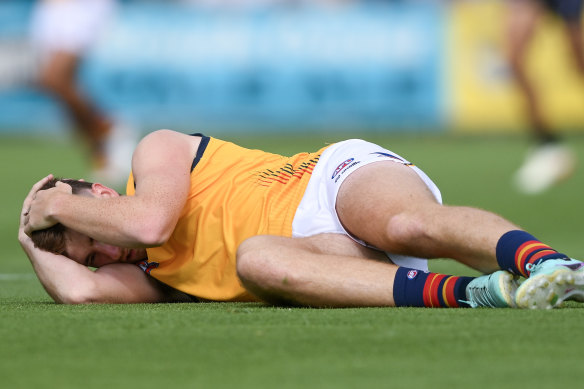By Peter Ryan
All footballers who suffer a concussion in competitions other than the AFL and AFLW will be required to miss at least 21 days after the AFL introduced a mandatory minimum three-week return to play protocol.
AFL and AFLW players will continue with a minimum 12-day return to play protocol as they have access to better medical care and diagnosis of concussion.

Adelaide’s Mark Keane holds his head after being concussed by Port’s Sam Powell-Pepper.Credit: Getty Images
The landmark decision will apply for state football competitions (including the VFL and VFLW), elite pathway competitions (including the Coates Talent Leagues for boys and girls) and all community football competitions.
The AFL will also work with the WAFL and SANFL to encourage them to adopt the same protocols.
The league claims the shorter minimum return to play protocols for AFL and AFLW players are possible because of the “advanced care settings” available to players at AFL clubs compared to community football. AFL and AFLW listed players concussed while playing state league football will also be subject to the 12-day return to play protocol.
Twelve days is the minimum number of days an AFL or AFLW player can return to play if they safely and medically clear the 11 steps in the protocol.
In 2023, when the minimum 12-day protocol operated in both the AFL and AFLW, 29% of AFL players missed more than one match following a concussion and 24% AFLW players missed more than one match following a concussion.
AFL legal counsel, Stephen Meade, said the decision was based on medical and scientific advice.
“We play a contact sport and there is always going to be risk, however over recent years we have continued to take action to strengthen match-day protocols and amend the laws of the game to discourage high contact, and we will continue to do so,” Meade said.
The AFL have also given the ARC concussion spotter the authority to direct clubs to conduct a SCAT test on a player if they notice an incident that involves “probable motor incoordination/no protective action” when it occurs.
The process a player needs to undertake before being cleared to play has been adjusted while clubs must report repeated concussions to the AFL’s chief medical officer Michael Makdissi.
The decision comes just one week after Melbourne midfielder Angus Brayshaw was advised to retire due to the effects of concussion and says after St Kilda defender Jimmy Webster was suspended for seven weeks for a bump that left North Melbourne co-captain Jy Simpkin concussed.
The new three-week return to play protocol for community competitions is in line with the AIS sports concussion and brain health position statement released on February 1 this year.
Under the community guidelines a player who is concussed can return to play on the 21st day after the day the concussion is sustained.
The guidelines also insist on an “individualised approach to return to play particularly where a player is 18 years or under, there is a history of learning disorders or mood disturbance that may affect the monitoring of recovery, or a history of multiple concussions, may necessitate a more cautious and conservative approach”.
Keep up to date with the best AFL coverage in the country. Sign up for the Real Footy newsletter.